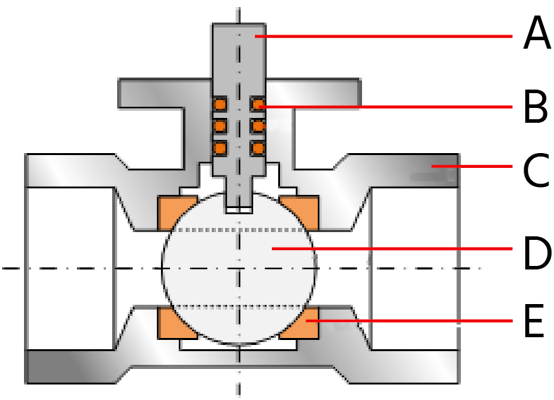Ball Valves Explained: Types, Principles, and Applications
What is a Ball Valve?
Ball valves are widely used in various industries for their reliability and efficiency in controlling the flow of liquids and gases. A ball valve is a flow control device that uses a hollow, perforated, and pivoting ball to regulate the flow through it. The valve is open when the ball's hole is in line with the flow, and it closes when the ball is pivoted 90 degrees by the valve handle.
Working Principle of Ball Valves
The ball valve working principle is straightforward. When the valve handle is turned, the ball rotates to open or close the flow. In the open position, the hollow ball allows fluid to pass through, while in the closed position, the ball blocks the flow. This simple mechanism provides a reliable and leak-proof sealing.
Ball Valve Diagram
Below is a diagram illustrating the main components of a ball valve:

It is important to know the five main ball valve parts to understand the working principle of a ball valve. The diagram of the ball valve in Figure 2 shows these five main components.
O-rings (B): O-rings on the valve's seat help prevent leakage.
Housing (C): The housing supports all the valve's inside components and protects them from application and environmental conditions.
Ball (D): The ball has a hollow bore through which fluid can flow when the valve is opened.
Types of Ball Valves
Ball valves come in various types, each suited for different applications:
- Two-Way Ball Valve: The most common type, allowing flow in two directions.
- Three-Way Ball Valve: Used to mix or divert flow, with three ports.
- Four-Way Ball Valve: Typically used in complex piping systems.
- V-Port Ball Valve: Offers precise flow control with a V-shaped ball.
Applications of Ball Valves
Ball valves are used in a variety of applications due to their durability and reliability. They are commonly found in:
- Water and wastewater treatment
- Oil and gas industries
- Chemical processing
- HVAC systems
- Pharmaceutical manufacturing
Benefits of Using Ball Valves
Some of the key benefits of using ball valves include:
- Quick and easy operation
- Reliable and leak-proof sealing
- Durable and long-lasting
- Low maintenance
Why Choose Pneucons for Ball Valves?
Pneucons is the best marketplace for purchasing ball valves due to our commitment to quality and customer satisfaction. We offer genuine and branded products at 10-15% cash discounts from verified sellers. Our extensive range of ball valves ensures that you find the perfect match for your industrial needs. Buy from Pneucons to ensure you receive high-quality, reliable, and efficient ball valves.
Conclusion
Understanding the various types and working principles of ball valves can help in selecting the right valve for your application. Whether you need a standard two-way ball valve or a specialized V-port valve, Pneucons is your go-to marketplace. Visit Pneucons today to explore our wide range of ball valves and take advantage of our exclusive discounts.
Related Articles
Understanding Solenoid Valve
Learn about solenoid valves, their function, working principles, and applications in various industries. Discover why Pneucons is the best marketplace to buy solenoid valves. Understanding Solenoid Valve Solenoid valves are electromechanical devices ...